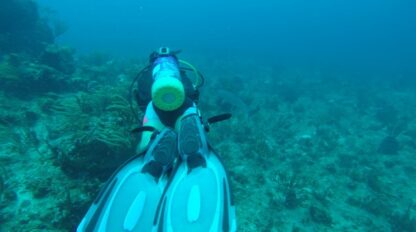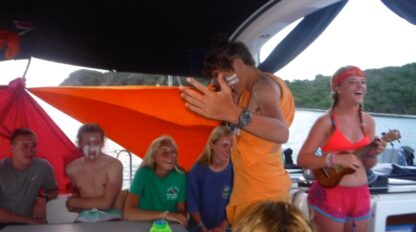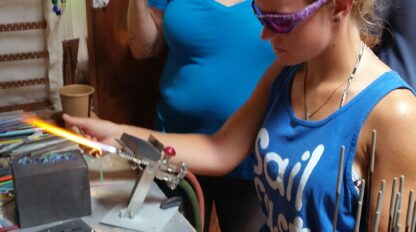Snorkeling Tips & Techniques for Beginners
 Snorkeling is an exciting and simple way to experience the wonders below the waters surface! I admit, the word “snorkel” sounds kind of silly and the equipment takes some getting used to, but with a little practice I’m certain you’ll feel very comfortable. Snorkeling is one of my favorite water activities, and though I am a certified scuba diver and love it, there is something special and exhilarating about the freedom you feel during a good snorkel or skin-diving session.
Snorkeling is an exciting and simple way to experience the wonders below the waters surface! I admit, the word “snorkel” sounds kind of silly and the equipment takes some getting used to, but with a little practice I’m certain you’ll feel very comfortable. Snorkeling is one of my favorite water activities, and though I am a certified scuba diver and love it, there is something special and exhilarating about the freedom you feel during a good snorkel or skin-diving session.
So, for those of you aren’t quite ready or aren’t cleared by a doctor to try scuba training, or if you want to experience the underwater world without all the hassle and bulk of dive gear, I have a few suggestions to prepare you for a successful and enjoyable snorkeling experience.
 Always snorkel with a buddy, no matter how experienced you are – and if you’re new to this try to pair up with someone who’s done it at least a few times. You are a team, so be sure that you communicate clearly with your buddy and/or group leader to let them know how experienced you are and your comfort level. Ask your buddy to discuss how they are feeling too!
Always snorkel with a buddy, no matter how experienced you are – and if you’re new to this try to pair up with someone who’s done it at least a few times. You are a team, so be sure that you communicate clearly with your buddy and/or group leader to let them know how experienced you are and your comfort level. Ask your buddy to discuss how they are feeling too!- Get comfortable with your gear on dry land! Whether you purchase your own mask, fins, and snorkel or you rent them, try everything on and understand how it all works before you dive in. That way if you need to adjust something in the water, you’ll be better prepared to fix it yourself.
- Once you are ready, choose a location that is calm and shallow enough for you to feel comfortable. Review a guide of the area if possible, such as this Guide to Diving and Snorkeling in the British Virgin Islands. Spit into your mask (or use a commercial de-fogger if you want to be fancy), rub it around, and rinse before fitting it onto your face to prevent the lenses fogging up. To avoid leaks, be sure that the edge of the mask is flush against your face and that there is no hair or anything trapped under it. Leaks are also often caused by masks being too loose or much tighter than they should be, so loosen up if you need to 🙂
- Practice floating still on the surface while breathing through your snorkel (your lips should be sealed around the entire mouthpiece, not only the little tabs). Here’s the trick – you only breathe through your mouth because the snorkel is your link to the air above. Your nose is sealed off by the mask, so if you try to breathe through your nose you will likely end up with a foggy mask and a few drops of water creeping in. It takes some getting used to because this style of breathing is backwards for most of us. Don’t worry, you’ll get it!
- Sometimes water floods into your snorkel. This happens when the top of your snorkel submerges (either because you ducked your head under water or if a wave splashes over your head), and is very normal and easy to correct. Simply blast air forcefully from your lungs out through your snorkel. The air will push the water out so you can breathe normally again. Need a visual? Watch this helpful video demonstration.
- Now that you have the breathing part down, it’s time to move around so you can see what there is to see! Snorkeling is not like regular swimming – you aren’t trying to be speedy. You want to move slowly through the water so you don’t frighten the wildlife. Keep your arms back by your sides (I usually clasp my hands behind my back so I don’t forget and let them flap around). Use only small flutter kicks to propel yourself gently through the water.
 Now you should be prepared with the basic skills to enjoy snorkeling on the surface of the water. But remember, the best way to learn or practice a new skill is to have someone teach you! Join Sail Caribbean for our Summer Teen Adventure Camps where excellent instructors teach you how to snorkel and then tour you around the beautiful coral reefs of the British Virgin Islands!
Now you should be prepared with the basic skills to enjoy snorkeling on the surface of the water. But remember, the best way to learn or practice a new skill is to have someone teach you! Join Sail Caribbean for our Summer Teen Adventure Camps where excellent instructors teach you how to snorkel and then tour you around the beautiful coral reefs of the British Virgin Islands!
If you feel comfortable with your snorkeling ability and want to get a little deeper (literally!), stay tuned for our Free-Diving Tips and Techniques (coming soon).


